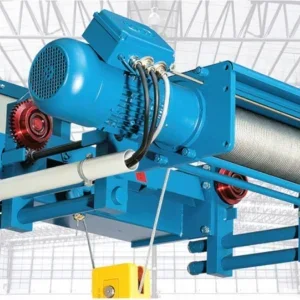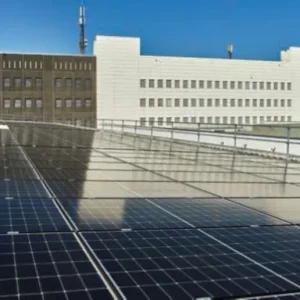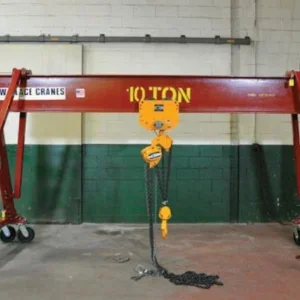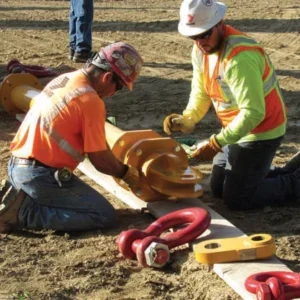Vetter
Vetter Krantechnik from Germany has revised its proven mobile slewing jib crane as a modular system, to create, the company says, a completely new concept.
The Mobilus crane is a jib and mast on a base of concrete rings, which give stability but which can be moved around the factory floor; the crane does not need to be fixed down, and new options now make moving it easier and more flexible. When the jib arm is locked for safe transport the crane base can be lifted using fork-lift pockets or be pulled using a drawbar/coupling system, and has lifting lugs so it can also be transported using a hall crane; it can also still be moved manually on its integrated wheeled trolley.
The modular design of the system is novel: the concrete crane base can be combined with different crane models. The customer can select the standard crane with a slewing range of 360°, or the 270° version with an underbraced jib arm, or a light-weight jib arm made of aluminium. Yet another option is an articulated jib arm to make it a handling crane. If, in the course of years, the user wants the crane for another purpose, there is no problem: the crane base can be raised by adding further concrete rings and another crane type can be installed on it. The whole system, says Vetter, offers utmost flexibility.
3I
German company 3i were intending to show its Basic system—a vacuum lifting device. Despite the name, this is new and sophisticated. “It replaces the traditional vacuum lifter,” says managing director Christian Viehmann. “Its huge advantage over those is that even though it is a vacuum system it is noiseless.”
The silent performance is achieved in the first moment of lifting. “At that moment we freeze the pressure inside the device; we keep it constant at that value throughout the lift and movement, and do not increase it.” The vacuum pump is therefore not working; and no air is consumed during the carry. “That delivers not only silence: it also gives an 85% energy saving.”
It is, he says, intuitive in the last degree to use. A pistol-grip handle has one ‘up’ button that you press with your index finger, and one ‘down’ button that you press with your middle finger. “And that is it,” says Viehmann. “No explanation on how to use it is necessary.”
The Basic system which can be mounted on any overhead support, such as 3i’s rail system or their mobile jib crane MobiArm.
Kito
The different variations of the EQ electric chain hoist are some of Kito’s bestsellers. Latest highlight of the range, and new this year, is the new single-phase EQS electric chain hoist. It is designed for 220–240V power supplies, while still providing all the advantages of the high-voltage version, such as compact design and versatile application possibilities.
Three-phase power supplies are the norm for factories, but many construction sites, repair shops and maintenance jobs have only 220v or 240v single-phase electricity. Nevertheless, they have heavy lifting tasks that need to be done. The new EQS hoist is designed for such situations; it can be simply plugged in to a power socket. With a capacity of 500kg or 1t, it can provide lifting exactly where it is needed.
The technical characteristics encompass a frequency inverter and the ‘No-load High-speed’ function which gives the EQS a lifting speed that is 1.3 times faster when lifting less than 30% of the full load. This technology also gives gentle and precise load positioning. Overload protection is provided electronically by the frequency converter and mechanically by the built-in and long-life friction clutch. The dual lifting speed and the maximum lifting height of 15m are, says Kito, an advantage for an electric chain hoist of this category.
It comes with an operating hours/load cycle counter, upper and lower limit switch and pull-rotor brake. All components of the EQS electric chain hoist are designed to be very robust, so there is little wear and low downtime. The unique Kito grade T, series DAT (G80) load chain is nickelplated to reduce hydrogen embrittlement and to secure high corrosion resistance.
The breaking strength of the installed load chain is 800N/mm². The sealed die-cast aluminium body means that the hoist is rated at IP55 protection class.
Durability comes also from the inside: the interior has been designed for long service life. The EQS doesn’t require any sensitive transformers or electromagnetic components such as contactors or relays. It is classified with FEM 3m at 500kg load capacity and with FEM 2m at 1,000 kg load capacity. It can be equipped with a top hook or a plain trolley instead of the standard hanging suspension.
At the other end, a self-closing safety load hook from Kito Weissenfels, the company’s Italian subsidiary, is available as an option, and a radio remote control can also be delivered on request.
Kito Erikkila from Finland provides industrial workplace systems, and was intending to showcase a light crane system and a slewing crane with an aluminium jib crane. In January Erikkila launched new seamless Prosystem profiles for their light overhead lifting systems. These S200 and S260 replace the older P200 and P260 profiles. A completely new profile size, the S140, was launched at the same time. All the new profiles have stronger suspension clamping areas.
SWF Krantechnik
SWF were intending to show their Nova Silverline and Nova Blackline electric wire rope hoists. The Silverline range is designed for loads up to 80t. The rope drum has an extra-large diameter to reduce rope wear to a minimum; the approach distance has been optimised; the hoist has ultra-low headroom requirements; and lateral hook movement is minimal. Frequency inverters and smooth movement also minimise the load swing.
The Nova Blackline is more basic than the Silverline but still offers the same advantages. Combining the electric wire rope hoist of the Blackline series with SWF crane kit components gives, says SWF, a robust, low cost crane solution for loads from 2t to 20t.
The hoists can be used with SWF’s crane kit components, such as their Profilemaster overhead rails and supports, to create a complete lifting system. Profilemaster comes in several versions, including the plus ST which is made of steel and designed for loads up to 2t.
It is highly flexible in arrangement; compatible components and optimised suspensions ensure a first-time assembly in what the company says is record speed.
The system can be extended or modified later as needed, again in minimal time.
Seven different steel profile types are available, in five sizes, for various loads and suspension distances. Two of these profiles are equipped with an internal conductor line.
All profiles are cold-formed and powdercoated, which makes them very rigid.
An alternative is their ProfileMaster plus AL, the lightweight aluminium version of the system, intended for buildings with low static load-bearing abilities. There are six different profiles in four sizes, two of them again with an internal conductor line. Reduced operating noise, smooth movements from specially-designed high performance running wheels, and gentle load handling are all advantages offered by the system, says SWF.
Both systems are flexible, with single and double-girder solutions, and joint or static design. SWF also planned to showcase its Athlo chain series, the company’s latest generation of chain hoists for loads of up to 5t. High security, performance and durability were the main development aims, along with easy maintenance and long service life. The hoist motor has a new 4:1 gear ratio which with redesigned cooling fins provide better cooling to extend the life of the hoist; a larger-diameter skipping clutch has additional grooves to improve the cooling effect of the gear oil and increase its service life. The limit switch has also been re-designed and can be used as an operating end switch. The compact design and new upper-eye suspension provide increased lifting height at the same suspension height. The brake responds instantly when the power is turned off and can handle 1 million cycles, or, with proper handling, a lifetime. All SWF electric wire and chain hoists and crane components are available in explosion-proof versions suitable for zones 1 and 2 or zones 21 and 22, so are safe and suitable for a wide range of uses and industries.
Columbus McKinnon
An innovation from Columbus McKinnon is the Magnetek-brand Tandem Crane Radio Remote Control System. This, the company says, is the ideal solution for situations where two overhead crane systems need to operate in conjunction with each other.
Tandem Crane Systems allow a single operator to easily control two cranes simultaneously, using a single transmitter, or two operators to control each crane at the same time. Hoist and traverse conditions on both cranes are monitored. Fault detection on one crane halts motion of second crane to prevent load shift or drop.
The systems can be easily programmed and feature a unique two-transmitter, tworeceiver package for advanced, reliable communication. Software-based logic reduces programming and set-up time, and status and diagnostic information, including battery lift, signal strength, and warning symbol are shown on a display screen. The status feedback eliminates, they say, the need for in-depth inspection, and decreases downtime. The system is IP66-rated and sealed to withstand harsh environments. Its plug-and-play design complies with EN 7121 and EN 15011 standards, and an optional Radio Control Programmer allows customisation of transmitter and receiver functions so the system can fit multiple applications.
Stahl CraneSystems and Magnetek have been united under the Columbus McKinnon umbrella since November 2017, and a recent result is two new intelligent chain hoists, the Stahl STF50 and ST20 which are being introduced under the Stahl label. Both are equipped as standard with Magnetek-brand frequency-inverter drives for lifting. They improve control, says the company, through precise, stepless lifting and travel and provide reliable feedback. Greater safety for the operator and less stress on structural, mechanical and control components are some of the benefits. Radio systems are also from Magnetek.
A newly-developed, simplified mounting of the encoder with 1024 ppr (pulses per revolution) gives reliable feedback even in rugged conditions of operation. Importance was attached during development to easy commissioning of the hoist.
Customers can also choose a frequency controlled drive. The big advantage here is that both frequency inverters are based on the well-established ‘Impulse G+ Mini’ Magnetek products. In general, all Stahl CraneSystems products will in future be equipped with inverters from the Impulse family. These can be parameterised both via external software and directly via input on the display.
Some previous features of the ST chain hoist series remain unchanged: ambient temperatures run from -10°C to 40°C, all voltage ranges are available, and there are many possibilities for individual adaptation.
The aim, says Thomas Kraus, head of product management at Stahl, is to guarantee safety and reliability into the future “We have come a great deal closer to Industry 4.0. Stepless travel and lifting combined with digital transparency protect both the operator and machine in equal measure.”
The frequency-controlled chain hoist will be launched on to the market in the course of 2020.
From their Yale brand, Columbus McKinnon’s latest product is the new Yale Mtrac endless winch. Its state-ofthe- art design that allows the winch to be operated vertically, at an angle, or horizontally. The model combines modern industrial design with technical innovation.
During development, the focus was on easy and safe handling for mobile applications. As an endless rope winch the rope is driven through the winch without storing it, so that almost unlimited lifting heights or pulling lengths are possible. A range of accessories for ropes and assemblies are available, which means that the winch can cover a wide variety of applications.
The company suggest, as just a few, construction, maintenance and installation of wind turbines, water management, energy supply, and overhead line work.
Demag
Demag has a brand new compact chain hoist in the DCBS, introduced in April 2020.
Its smart control system, they say, makes assembly and, especially, joining processes even simpler and safer. In its basic function, the DCBS is a variable-speed chain hoist based on the proven DCS range and has perfect command of the usual tasks of this hoist. The operator controls it by the D-Grip Servo control handle, and the load with a maximum weight of 125kg or 160 kg is raised or lowered by an electric motor.
What sets the DCBS apart from other chain hoists is its integrated balancer function, which has been adopted from the Demag D-BE electric balancer. It allows loads to be guided without the need to actuate the controller. The operator simply moves the load, by hand or finger pressure, to the desired height with little force, and can position it much more precisely with both hands because he does not have to take the ‘detour’ via the control panel. This makes the work much easier—and not only when exact positioning is required.
By actuating a switch, or automatically depending on the selected control mode, the DCBS unit switches between the ‘grip control’ and ‘load control’ operating modes, which gives intuitive load control. High-performance sensors on the hoist allow this function.
The manual force exerted by the operator is detected in the grip control system by a pressure sensor and is used to control the lifting motion. This eliminates the need for the operator to press any buttons to control the hoist. An integrated load sensor detects the weight of a load and possible weight fluctuations and, in load control mode, determines the desired direction of movement and speed from these values.
This allows the operator to move the load to the desired position using both hands. In assembly mode, which is particularly suitable for horizontally joining components, any possible uncontrolled load movements are suppressed and converted into a gentle swaying motion.
This enables components to be joined precisely. It also avoids possible damage from collisions between the parts and thus increases handling rates during assembly.
The fourth DCBS operating mode is ‘load pick-up’. This function is useful when, for example, changing tools or removing parts from jigs or test benches. The balancer can be adjusted so that it only lifts until a preset force is reached. It thus enables load handling attachments to be lifted and pre-tensioned—with the result that the load can be removed from a jig, for example, without dropping or being suddenly pulled upwards. At the same time, the machine or jig is protected against excessive forces.
All operating modes are linked to additional protection and safety functions, such as adjustable load or speed limits, and make working procedures even safer.
When it is combined with the Demag KBK light crane system, DCBS creates mobility for horizontal load transport. It can travel on KBK profile section rails, for example, on single-girder suspension cranes or in system suspension monorails and slewing jib cranes.
Besides its innovative direct load control, DCBS has design features that simplify its operation, improve safety and reduce service requirements. These include a slipping clutch with automatic cut-out based on speed monitoring, which prevents permanent slipping in the event of overload. Because the brake is arranged in front of the slipping clutch, in the load-bearing arrangement any dropping of the load is effectively prevented and, in the event of a malfunction, the brake is applied automatically.
All of these measures together mean that the gearbox, slipping clutch and brake are maintenance-free for up to ten years, and that the safety-related functions satisfy Performance Level C and Category 2 to EN ISO 13849-1 as a minimum requirement.
The DCBS therefore makes work easier for the operator, says Demag, enables very precise and safe load handling, and becomes a tool in itself, opening up new tasks beyond the simple lifting of loads.
Kuli
Kuli were planning on bringing something quite different to the Logimat exhibition.
“What we wanted to bring is a model calculation for different types of cranes,” says export manager Oliver Riese. The calculations would demonstrate the energy savings that would result from using Kuli’s smarter energy recuperation system smarter—the capital ER standing for Energy Recuperation.
“We would have had the possibility to do these calculations, at the exhibition stand, for visitors’ own cranes,” says Riese.
As an example, for a 6.3t bridge crane using 6kw of lifting power at 30% usage over a single 8-hour shift each day, over 250 working days would use 1,800kWh of energy a year. The same crane with Kuli’s energy recuperation system fitted would use 540 kWh. The saving would seem hugely worthwhile.
Savings for other capacities of cranes, with other usage patterns, can be calculated also.
“Of course this is only an abstract figure, as the real savings are depending on a whole bunch of factors, mostly related to the usage of the crane that vary with each case,” says Riese. “But it gives a first impression at least and is as realistic as it can be.”
You must remember, he says, that when traditional cranes are lowering their load energy is wasted as heat, generated in the brake resistors.
“Those brake resistors can be large, depending on the motor power of the crane, and their initial costs were on a similar level as costs for the Kuli smartER energy recuperation system, which can recover much of that wasted energy.”
Put briefly, Kuli’s smartER energy recuperation units feed the nascent braking energy of frequency-inverter-controlled drives directly back into the grid. The method of operation is that while braking, the motors work as generators, which produce AC. The frequency inverters convert this into DC.
Instead of being wasted by brake resistors this DC is transformed by the recuperation units into sinusoidal AC, which is fed back into the local grid. The feedback is synchronous in phase and amplitude to the local network, which means that the network quality is secured and other consumers are not influenced by parasitic induction.
“The obvious advantages are energy efficiency and savings and minimum wasted heat,” says Riese. “The Kuli fitments are significantly more compact than brake resistors; their network performance is the same as that of a frequency inverter.
“The system is especially suitable for applications with high inertia, such as is usual in larger bridge- or gantry cranes.
The savings are such that an amortisation period of just one year can be expected.”
The units are available in 7.5 kW and 15 kW versions and can easily be connected for higher power rates. The modules are extremely compact and are installed in the control cabinet.






